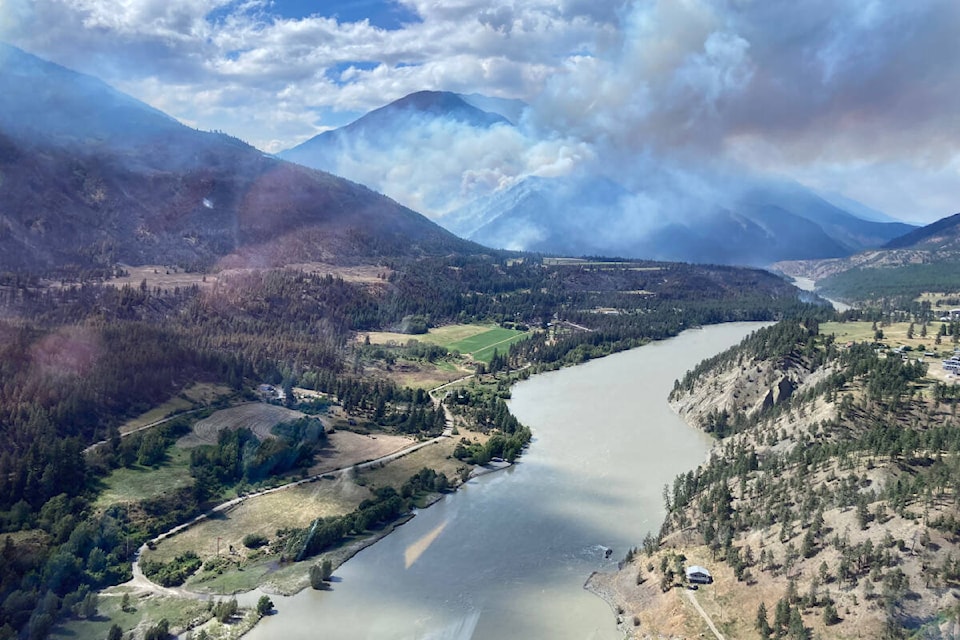The Nohomin Creek wildfire, which started near Lytton on July 14, had grown to 2,058 hectares as of Tuesday, July 19.
The fire started on the west side of the Fraser River approximately 1.7km northwest of the village, which was almost completely destroyed by fire on June 30, 2021. It has been moving in a northwesterly direction along the Fraser River, fuelled by heavy winds of up to 60 km/hr in the area. Steep terrain, heavy smoke, and accessibility are presenting challenges for crew working at the site.
Lytton First Nation and the Thompson-Nicola Regional District have issued evacuation orders and alerts for numerous properties. Emergency Support Services (ESS) are available in Lillooet and Cache Creek, with more than 30 residents having to seek refuge in Cache Creek after Lillooet reported having no more available space.
Those seeking to leave the area were hindered by a lack of egress routes. The road along the west side of the Fraser towards Boston Bar is not passable, as sections were destroyed in the flooding in November 2021, and the Lytton ferry is out of service due to high water. The foot bridges across the Fraser to the west and northwest of Lytton were clear, but road access to Lillooet along the west side of the Fraser was in danger of being cut off by fire.
Lytton First Nation Acting Chief John Haugen has confirmed that at least six residences have been destroyed. Numerous outbuildings are also known to have been lost. There have been no reports of any casualties.
Crews are working on the south, east, and north ends of the fire to support line construction and structure protection efforts. The western flank of the fire has been growing upslope in steep, inoperable, and difficult to access terrain that poses significant safety challenges.
The fire’s western flank is advancing toward the Stein Valley Nlaka’pamux Heritage Park, and Lytton First Nation and BC Parks are working together to identify cultural values and sensitive sites, as well as other recreational and ecological values, and the best methods to protect them.
The Stein Valley Nlaka’pamux Heritage Park is co-managed by Lytton First Nation and BC Parks, who work in partnership to protect the ecological and cultural significance of the Stein River Valley. The park has a Fire Management Plan which outlines the course of action to take should a wildfire start in, or enter, the park. The Fire Management Plan identifies the valley bottom, the walking trail, and watershed as areas where suppression efforts may be permitted.
The Fire Management Plan for the park highlights the importance of preserving its ecological integrity. Fire suppression tactics that involve the use of heavy equipment and fire retardant from aircraft cannot be utilized. Given the remote, difficult access and the priority of firefighter safety, portions of this fire will be put under Modified Response. Fire suppression efforts will be limited to the valley bottom to protect park infrastructure, cultural values, and the Stein Valley hiking trail where it is possible to do so.
A warming and drying trend is forecast for the coming week, resulting in fuels drying out and becoming more susceptible to ignition. The fuel load in the area is heavy, and as the Nohomin Creek wildfire progresses west, fuels in the Stein Valley Nlaka’pamux Heritage Park will be consumed. Large amounts of smoke will be emitted, and intense wildfire behaviour may be observed.
The crews working along the Stein Valley walking path have made progress with a hose lay and establishing a sprinkler system. That work will continue as crews extend the hose lay and sprinkler line further up the walking path. Crews will continue to patrol and extinguish any smokes and hot spots that occur as temperatures warm up.
The Nohomin Creek wildfire is classified as Out of Control, and was human-caused. The exact cause has yet to be determined.
editorial@accjournal.ca
Like us on and follow us on



